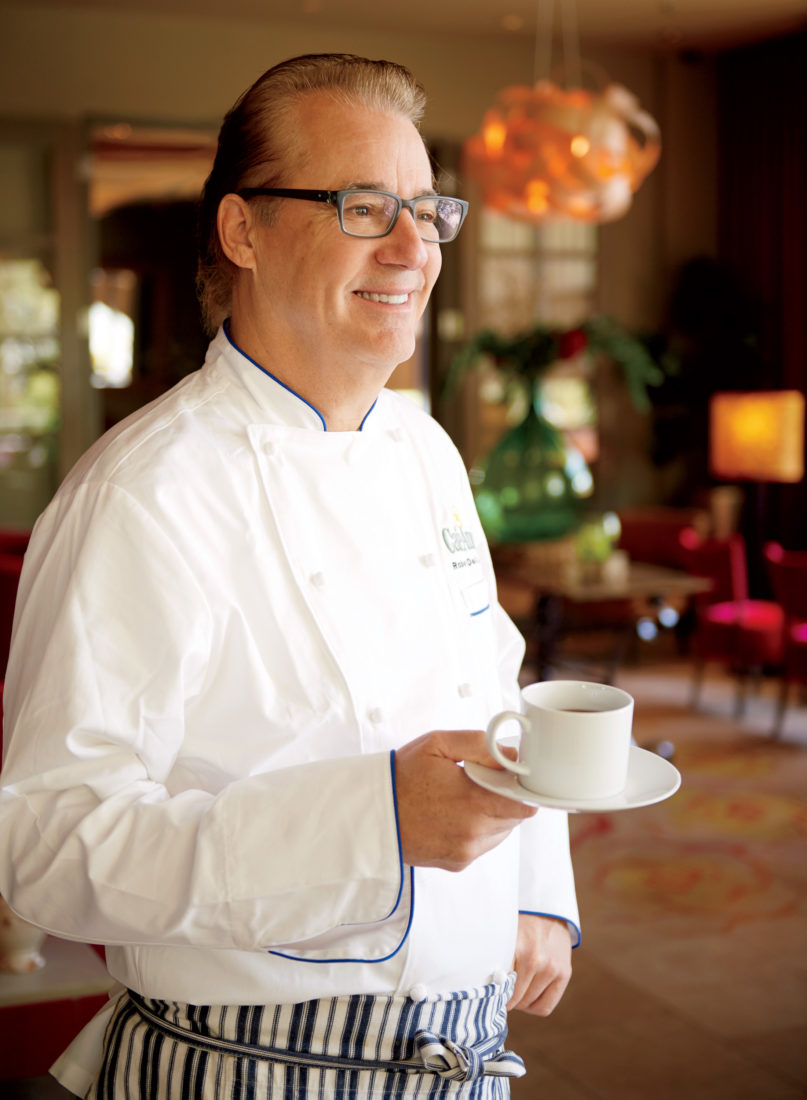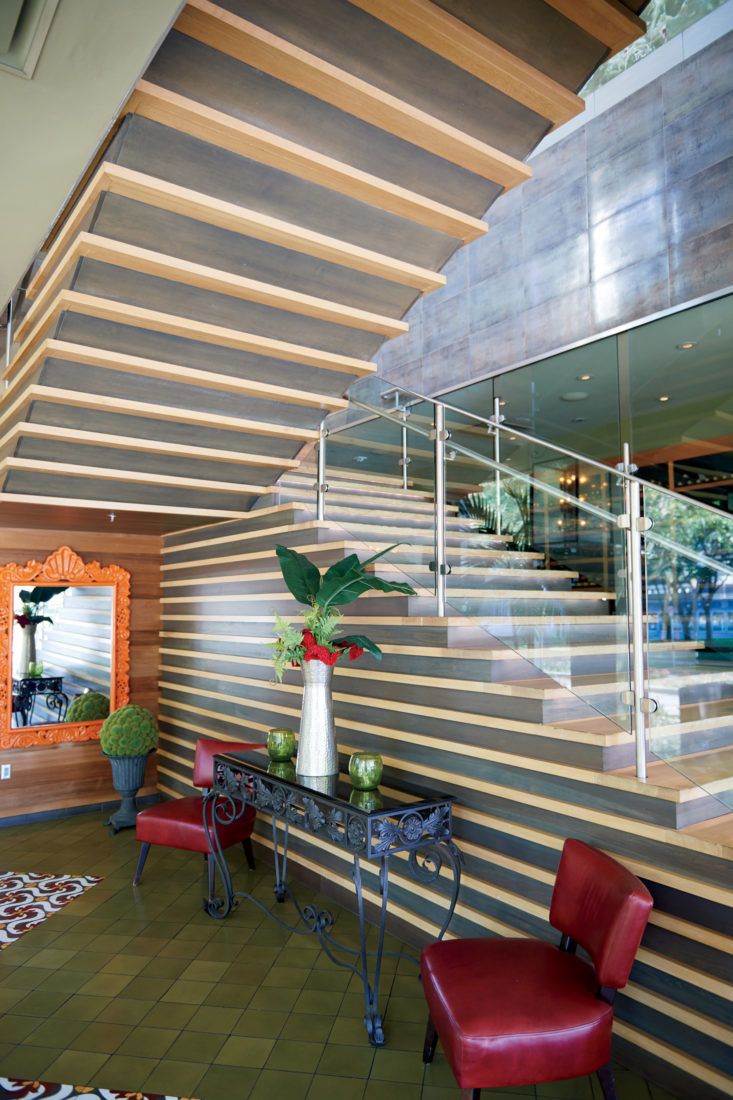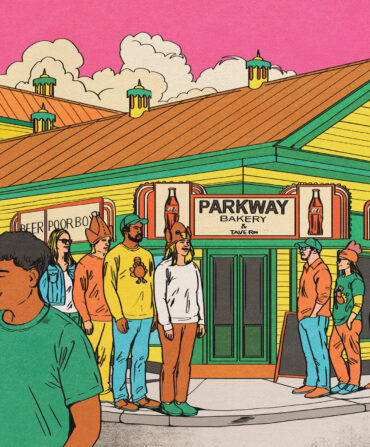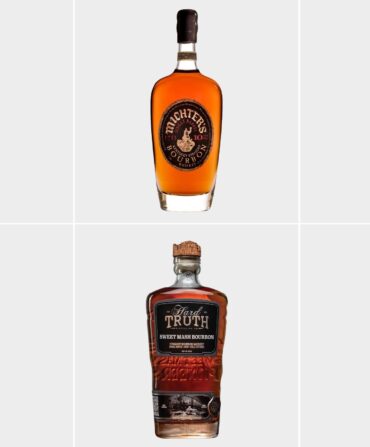Dressed in a striped vest, Adrian Marquez, a veteran waiter at Cafe Annie in Houston, grips a white pitcher brimming with russet liquid. Into a wide-rimmed white bowl, haystacked with akimbo strips of fried tortilla, he pours soup in a swift flourish, and I spoon toward the queso fresco turning from squeaky curds to sharp streaks of liquefied cheese.
The tortilla soup tastes of leathery ancho chiles and dusky oregano. It tastes, too, of the 1980s, when the original Cafe Annie was a showcase restaurant for Southwestern cuisine. Before Cafe Annie, black beans were thought queer by much of the dining public. For most Anglos, the word mole conjured a small furry mammal adept at subterranean burrowing, not a sauce made with chiles and chocolate.
Last year, Robert and Mimi Del Grande shuttered RDG + Bar Annie, their swish and modern second act, and reprised Cafe Annie in RDG’s same tree-house space, perched above a thrumming Houston thoroughfare. With that move, they beckoned the faithful to revisit a time when Southwestern cuisine was nouvelle and the hardest Texas table to win was a Saturday-night Cafe Annie four-top. Intrigued to dine at a living museum of American regional cooking, I followed.
Thirty-six years have passed since Robert Del Grande, a California native with a doctorate in biochemistry and a yen for Mexican cookery, accompanied the woman who became his wife to Houston, where her sister and her husband ran a French-inspired restaurant. When the original chef departed, Del Grande stepped into a position he thought was temporary.
With the gusto that Paul Prudhomme exhibited when he reinvented the Creole menu at Commander’s Palace in New Orleans, Del Grande ditched Cafe Annie’s bistro-style steak frites for coffee-rubbed tenderloins napped with pasilla chile broth. Wearing chef whites, talking comal-toasted spices, Del Grande sold the smoky pleasures of rabbit enchiladas and the sweet brininess of lump crab tostadas to an audience that was slowly awakening to regional cuisines. Long before the press regularly referred to chefs as rock stars, he performed in the Barbwires, a twang rock band he founded with the Dallas chef Dean Fearing. In 1992, he won the Best Chef: Southwest award from the James Beard Foundation.

Photo: Ralph Smith Studios
Robert Del Grande at Cafe Annie.
Del Grande and his cohort inspired a generation of chefs. Emeril Lagasse introduced crawfish rellenos with red bean sauce to New Orleans diners. Bobby Flay delivered red chile barbecued duck to New York City. Grilled salmon swaddled in avocado puree was soon omnipresent. But widespread acceptance drove eventual disinterest. By the time Del Grande refashioned Cafe Annie into RDG in 2009, vanguard dishes such as his black bean terrine, threaded with goat cheese, had become repertory fare in the New American canon. Trend surfers who once flocked to Cafe Annie queued for tables elsewhere.
Today, those dishes and that Cafe Annie vibe await rediscovery. I focus my choices on Del Grande standards such as that tortilla soup. And crab tostadas with slaw. And cinnamon-roasted pheasant confit. And nachos, topped with chunky red chile beef, glossy black beans, a shellac of cheese, and a plume of guacamole. Imagine a seven-layer dip, artfully plated for a photo shoot. Each bite of that baroque mid-eighties assemblage—arrayed on fried tortilla chips cut to serve as spoons, flanked by jalapeño slices with the seeds thoughtfully removed—reminds me why this food excited the first time around. Those nachos are playful. And excessive. They beg sharing. And they’re deeply satisfying.
Cafe Annie once again draws swells. Especially at lunch. Gathered at velour booths, amid a forest of metal cactus sculptures, men shoot monogrammed cuffs to reveal gold watches. Against a backdrop of umber and turquoise folk murals, women in Lucite armchairs drum lacquered nails on granite tabletops, drink Napa whites, and murmur about portfolio forecasts.

Photo: Ralph Smith Studios
Inside the revived restaurant’s front entrance.
Some tastes have been gently updated. Sriracha now dots plates of chicken-fried steak and mashed potatoes. Polpettes of shrimp and chorizo, served with a smoked chile cocktail sauce and biscuits, bring to mind recent chefly marriages of sea and land. Once a celebration of trophy vintages from California and Europe, the wine list now features a bright tempranillo from Becker Vineyards in the Texas Hill Country.
Back when Cafe Annie became RDG, it seemed that time had passed Southwestern cuisine by. White-tablecloth nachos were delicious, but they were no longer courant. With this rebirth, the Del Grandes have managed a sleight of hand. They have turned something old into something new. And they have reminded diners that when chefs dig deep into their past, they don’t have to choose between exciting flavors and enduring nostalgia.
At Cafe Annie, past and present do more than coexist. They complement. Diners gain perspective on the early days of the Southwestern cuisine movement, back when America was rethinking and reframing its culinary identity, when tortilla soup and black bean terrine were worthy of attention. Here, in wildly multicultural Houston, from a perch among the live oaks, the chef who helped ignite that movement reminds us that those days and those foods are worth championing anew.








